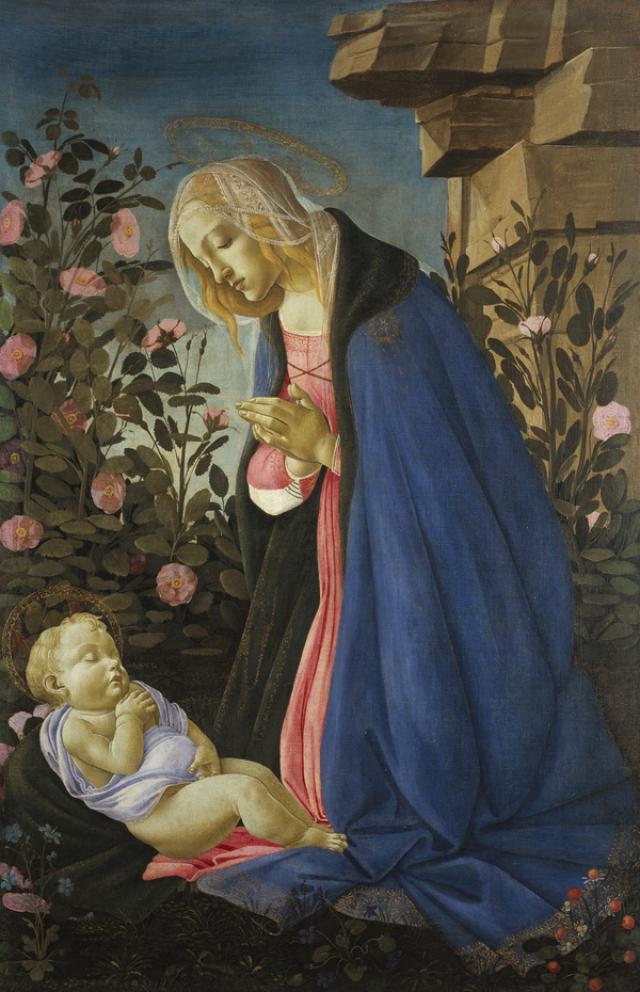Anya Gallacio's 'Red on Green', an installation of 10,000 red roses which wilt and decay over time, stimulated visitors' senses in 2019 at the Scottish National Gallery of Modern Art. This blog explores the significance of the rose within some works from our own collection.
The Virgin Adoring the Sleeping Christ Child
In art, literature and culture, roses have long been regarded as symbols, of romance in particular. This connection is thought to originate from Egypt, where Cleopatra famously carpeted the floor of her boudoir with mounds of rose petals to seduce Mark Antony. The ancient Greeks and Romans associated the rose with the goddess of love, Aphrodite or Venus.
In Sandro Botticelli's The Virgin Adoring the Sleeping Christ Child, the beautiful rose bower forms an 'enclosed garden', a symbol of the Virgin derived from the Old Testament Song of Solomon.
The tender, intimate image draws the spectator into the privacy of the garden setting. The luxuriant rose bushes and the carpet of plants and flowers are painted with a particular fluency, yet every detail here carries symbolic significance.
In mediaeval and early Renaissance art, the enclosed garden (hortus conclusus) is a commonly used symbol of Mary’s virginity while the bower of thornless roses refers to her Immaculate Conception as the Mother of God, born without original sin.
A Lady's Left Hand Holding a Rose. Study for the Painting 'The Artist's Wife: Margaret Lindsay of Evelick
This study by Allan Ramsay focuses delicately on only a woman's hand holding a rose. It is a striking sketch, produced just after he and his wife returned to Scotland from his second visit to Italy. In Italy, Ramsay drew numerous studies of the old masters in an attempt to integrate something of their gracefulness into his own work. This drawing shows his interest in capturing the detail and elegant pose of his sitters.

The Pink Rose
Another delicate example of rose imagery is seen in Annie French’s The Pink Rose. Primarily an illustrator of fairy tales and poems, French was a key figure in the Glasgow Style movement which emerged in the 1890s. This style drew upon other prominent design styles of the time, such as the Aesthetic Movement, the Arts and Crafts Movement and European Art Nouveau. The common ground of the practitioners was the Glasgow School of Art.[1]
From Briar Rose to Snow White, roses are a common symbol interwoven into fairy tales. In fact, roses have long been a key symbol in literature. So much so that the term 'The Wars of the Roses' only came into common use in the 19th century after the 1829 publication of Anne of Geierstein by Sir Walter Scott. Scott based the name on a scene in Shakespeare’s play Henry VI where a number of noblemen and a lawyer pick red or white roses to show their loyalty to either the Lancastrian or Yorkist house.[2]
Pink Roses
In contrast to the delicate roses of French’s illustration, Pink Roses, Chinese Vase by Samuel John Peploe was painted during a time when he was experimenting with areas of bright colour. He felt that every plane was to be represented by a change of hue and selected items that could be treated in flat areas of strong colour, such as the roses in this painting.
Roses
The subjects of William MacTaggart's 1959 work Roses are also expressively represented, frozen in a bright and eternal full bloom. This is in opposition to Gallaccio's Red on Green, the roses of which remain on display during their decaying process.
The duplicity of the symbolism of roses can be seen in the Roman custom of hanging a rose (or a painting or a carving of one) over the heads of those in a confidential meeting. It was a reminder that the discussion could not be repeated outside the room. The term ‘sub rosa’ is today used to describe such meetings and means ‘under the rose’. Henry VIII made this practice more widespread, and the carving of roses into ceilings is a design that we still see today.[3] Here, the rose changes from an indicator of passion to one of restraint and secrecy.



